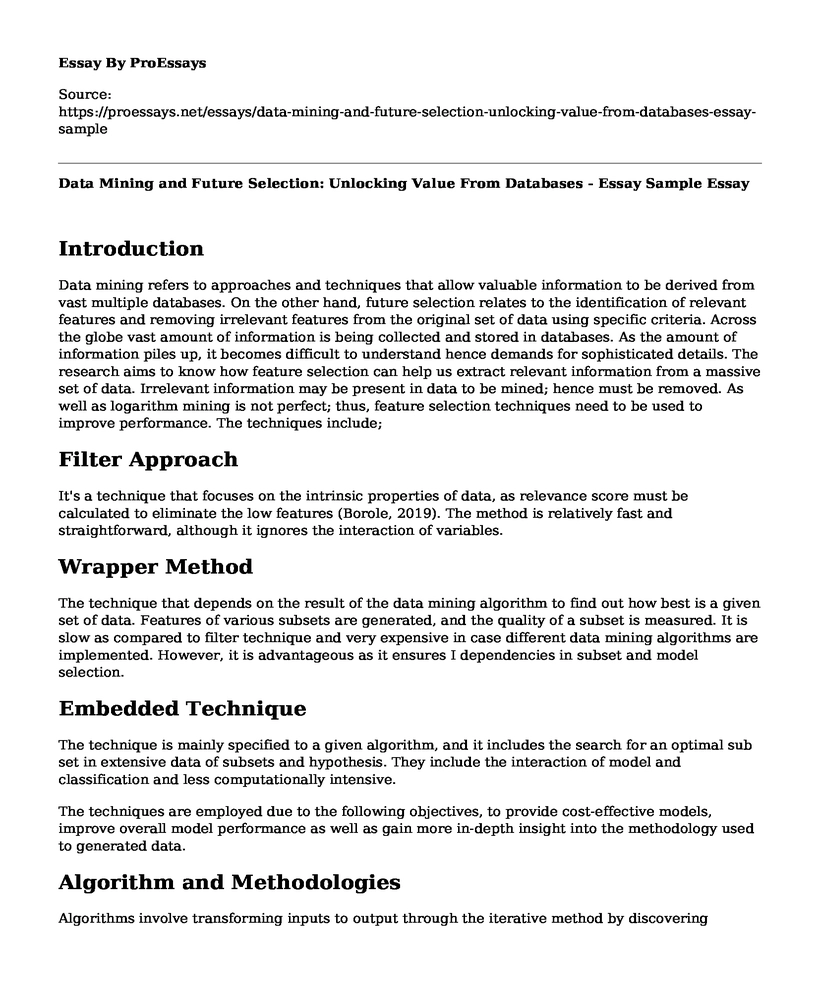Introduction
Data mining refers to approaches and techniques that allow valuable information to be derived from vast multiple databases. On the other hand, future selection relates to the identification of relevant features and removing irrelevant features from the original set of data using specific criteria. Across the globe vast amount of information is being collected and stored in databases. As the amount of information piles up, it becomes difficult to understand hence demands for sophisticated details. The research aims to know how feature selection can help us extract relevant information from a massive set of data. Irrelevant information may be present in data to be mined; hence must be removed. As well as logarithm mining is not perfect; thus, feature selection techniques need to be used to improve performance. The techniques include;
Filter Approach
It's a technique that focuses on the intrinsic properties of data, as relevance score must be calculated to eliminate the low features (Borole, 2019). The method is relatively fast and straightforward, although it ignores the interaction of variables.
Wrapper Method
The technique that depends on the result of the data mining algorithm to find out how best is a given set of data. Features of various subsets are generated, and the quality of a subset is measured. It is slow as compared to filter technique and very expensive in case different data mining algorithms are implemented. However, it is advantageous as it ensures I dependencies in subset and model selection.
Embedded Technique
The technique is mainly specified to a given algorithm, and it includes the search for an optimal sub set in extensive data of subsets and hypothesis. They include the interaction of model and classification and less computationally intensive.
The techniques are employed due to the following objectives, to provide cost-effective models, improve overall model performance as well as gain more in-depth insight into the methodology used to generated data.
Algorithm and Methodologies
Algorithms involve transforming inputs to output through the iterative method by discovering unknown patterns.
Decision Tree
It is an alternative data mining technique as it can convert the complex dataset into easy to understand information through a graphical diagram (Borole, 2019). The pictorial tree includes the minimal requirement for data preparation and provides precise and reliable information on large datasets.
Bayesian Networks
It represents a joint probability distribution over a particular set of data consisting of the nodes and arcs
Rough Sets
Are games with a boundary line upon which they cannot be classified. It contains lower approximation attributes whereby the objects belong to a set, and it acts as a boundary region. It provides efficient logarithms for tracing hidden data identifies hidden relationships between data, employees, both qualitative and quantitative data, and it's easy to understand and apply.
Genetic Algorithms
They are based on genetics for complex data that requires efficient and effective search mechanisms. It applies to population, for instance, a set of candidates whereby each solution arrived at is obtained through encoding to represent the solution as a chromosome. The population must be randomly selected and assigned a characteristic by fitness method, and the reproductive operator of mutation and crossover are applied to achieve the expected result.
Feature selection has been taken into consideration in the modern world due to huge volumes of data available in every field. Thus necessary methods have been employed to ensure relevant and essential data is available for individuals to access and use hence a very crucial area in data mining.
References
Borole, Y. (2019). Study on Feature Selection in Data Mining. International Journal For Research In Applied Science And Engineering Technology, 7(5), 3956-3958. doi: 10.22214/ijraset.2019.5652
Cite this page
Data Mining and Future Selection: Unlocking Value From Databases - Essay Sample. (2023, Apr 24). Retrieved from https://proessays.net/essays/data-mining-and-future-selection-unlocking-value-from-databases-essay-sample
If you are the original author of this essay and no longer wish to have it published on the ProEssays website, please click below to request its removal:
- Evaluation Essay on Windows 7 Firewall
- Essay Sample on Cybercrimes/Cybersecurity
- Essay Sample on Cybersecurity Threats and Vulnerable Assets
- Data Security and Privacy Protection in Cloud Computing - Research Paper
- Paper Example on E-commerce Quality: Ensuring a Well-Built Site for the Digital Age
- Get Acquainted with Data Set: 5 Visualization Tips
- Infrastructure as Code - Research Paper Sample







